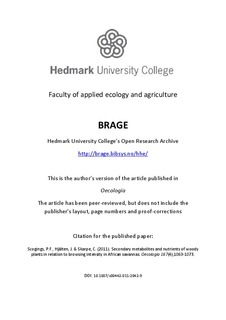Secondary metabolites and nutrients of woody plants in relation to browsing intensity in African savannas
Journal article, Peer reviewed
Permanent lenke
http://hdl.handle.net/11250/134430Utgivelsesdato
2011Metadata
Vis full innførselSamlinger
Originalversjon
Scogings, P.F., Hjälten, J. & Skarpe, C. (2011). Secondary metabolites and nutrients of woody plants in relation to browsing intensity in African savannas. Oecologia 167(4),1063-1073. 10.1007/s00442-011-2042-9Sammendrag
Abstract Carbon-based secondary metabolites (CBSMs) are assumed to function as defences that contribute to herbivore-avoidance strategies of woody plants. Severe browsing has been reported to reduce concentrations of CBSMs and increase N concentrations in individual plants, causing heavily browsed plants to be characterised by N-rich/C-poor tissues. We hypothesised that concentrations of condensed tannins (CT) and total polyphenols (TP) should decrease, or N increase, in relation to increasing intensity of browsing, rendering severely browsed plants potentially more palatable (increased N:CT) and less N-limited (increased N:P) than lightly browsed ones. We sampled naturally browsed trees (taller than 2 m) of four abundant species in southern Kruger National Park, South Africa. Species-specific relationships between N:CT, CT, TP and P concentrations and increasing browsing intensity were detected, but N and N:P were consistently invariable. We developed a conceptual post-hoc model to explain diverse species-specific CBSM responses on the basis of relative allocation of C to total C-based defence traits (e.g., spines/thorns, tough/evergreen leaves, phenolic compounds). The model suggests that species with low allocation of C to C-based defence traits become C-limited (potentially more palatable) at higher browsing intensity than species with high allocation of C to C-based defences. The model also suggests that when N availability is high, plants become C-limited at higher browsing intensity than when N availability is low.
Beskrivelse
This is the postprint version of the article. The original publication is available at www.springerlink.com
